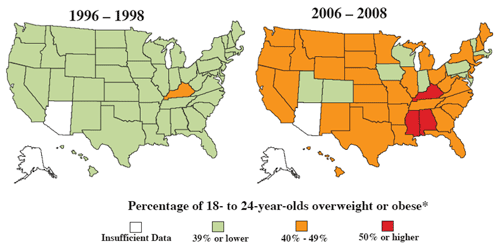Back in 1946, the original National School Lunch Act was passed in part with prodding from the military. Many American men, especially those who had grown up during the Depression, simply weren’t well-fed enough to fight. As a result of their stunted growth, soldiers who served in World War II were on average more than an inch-and-a-half shorter than young men serving in Afghanistan today.
The problem tied for the first time the seemingly unrelated policy arenas of national security and nutrition.
That link has largely been lost to history textbooks. But now, more than three generations later, it is resurfacing in Washington this year with an ironic twist: More than a quarter of recruitment-age Americans are today “too fat to fight.”

Miller-McCune’s Washington correspondent Emily Badger follows the ideas informing, explaining and influencing government, from the local think tank circuit to academic research that shapes D.C. policy from afar.
So concludes a bluntly titled report that has been cited by legislators working this spring to reauthorize the Child Nutrition Act. The bill would tighten nutritional standards on school meals and push much of the junk food out of the cafeterias and vending machines where many children get the bulk of their daily diet.
From the perspective of the more than a hundred retired admirals and generals behind the report, the program the U.S. once created to feed kids something is now feeding them all the wrong things.
“It’s the flip side of the same coin,” said Amy Dawson Taggart, the national director of the organization, Mission: Readiness, that produced the “Too Fat to Fight” report. “Back then, people were undernourished, and today they’re poorly nourished. This is not about just looking good in a uniform, it’s about being healthy and fit to do the work of the nation. And that’s exactly what it was back in 1946.”
The report examined data from the Centers for Disease Control and Prevention and found that 27 percent of young adults aged 17-24 — at least 9 million Americans — are today too overweight to join the military.
Mission: Readiness, which grew 18 months ago out of concern by retired military leaders over recent trends in the population, released a report last fall examining the rise in felonies and the decrease in high school diplomas that are hampering recruitment. In total, the organization found, 75 percent of young Americans don’t qualify today for military service for one of these two reasons or medical rejection, most frequently because of obesity.
A decade ago, Kentucky was the only state in America with at least 40 percent of its young-adult population considered obese by the CDC. Today, 39 states fit that description. In Kentucky, Mississippi and Alabama, more than half of 18- to 24 year-olds are obese.

Of these potential recruits, the military turned away 140,000 people between 1995 and 2008 for weight reasons. And it has to discharge every year more than 1,200 first-term enlistees for the same reason.
If you consider that it costs about $50,000 to retrain each of their replacements, Dawson Taggart said, simply losing soldiers to obesity before their first contracts expire costs the country $60 million a year. That doesn’t even touch the costs of treating obesity-related health problems for soldiers and their families in the military’s Tricare system or the VA.
“When we look at that, those figures are just alarming,” Dawson Taggart said. “The feeling of the generals and admirals was, look, we need to get a grip on the schools. We’ve got to look at each of these factors, but we have got to start dealing with these schools, especially as Congress has the ability right now to address this with the Child Nutrition Act.”
High-level military involvement (albeit from retired leaders) can only bolster the arguments already being made by individual teachers and nonprofit child advocacy groups with less clout in the Capitol. The House of Representatives even passed this month an amendment to the defense reauthorization bill, citing the opening lines of the “Too Fat to Fight” report, explicitly recognizing hunger and obesity as problems of national security.
Today’s military arguably contains many jobs that might not require the svelte BMI index once necessary to tromp through trenches with a 60-pound pack, especially as technology shifts to more battles won with joysticks than foot soldiers. But Dawson Taggart dismisses the idea that the military’s fitness requirements should expand with the times, and our waistlines.
“It’s not practical to have a cadre of overall people who are not physically fit,” she said. “Even chaplains, they may get sent into service at any time. The idea is if you’re in the military, you could be deployed.”





